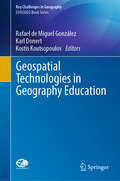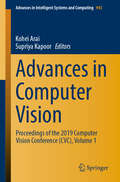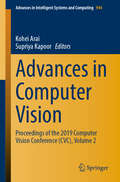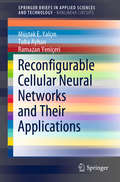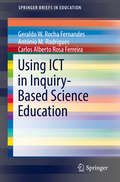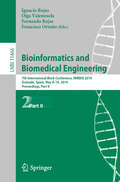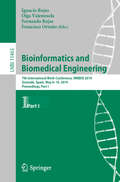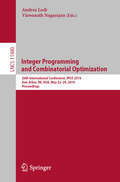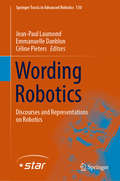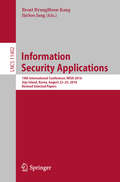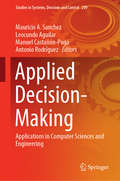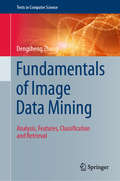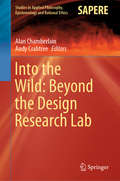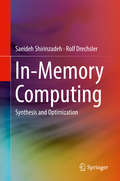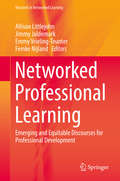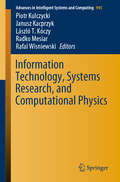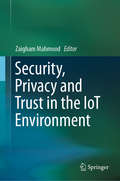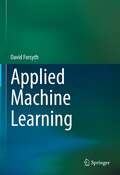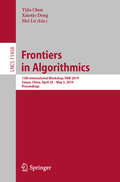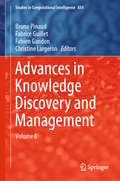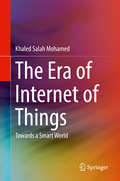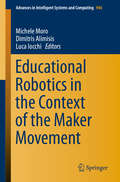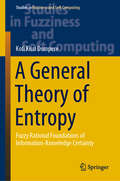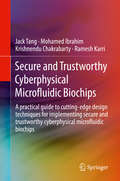- Table View
- List View
Geospatial Technologies in Geography Education (Key Challenges in Geography)
by Rafael de Miguel González Karl Donert Kostis KoutsopoulosThis book addresses new pedagogies focusing on the use of geospatial technologies and geomedia in the classroom. Today, geospatial technologies are substantially influencing geography teaching and learning, particularly in secondary education. Web-GIS, virtual globes, storytelling, maps and apps for mobile devices are transforming the nature and design of geography curricula, instructional processes, didactics, resources and assessments. Undoubtedly, geography is among those school subjects that have benefited most from the implementation of new technologies in the classroom. Geospatial technologies can be used to develop inquiry-based learning or project-based learning pedagogies and help students to acquire spatial reasoning and spatial citizenship skills in the context of education for sustainable development.This book highlights a range of initiatives, projects and educational practices – from several European countries and settings – related to geospatial challenges in geography education. Given its scope, it will be equally appealing to scientists, students and teachers of geography and other fields using geospatial technologies and geomedia.
Advances in Computer Vision: Proceedings of the 2019 Computer Vision Conference (CVC), Volume 1 (Advances in Intelligent Systems and Computing #943)
by Kohei Arai Supriya KapoorThis book presents a remarkable collection of chapters covering a wide range of topics in the areas of Computer Vision, both from theoretical and application perspectives. It gathers the proceedings of the Computer Vision Conference (CVC 2019), held in Las Vegas, USA from May 2 to 3, 2019. The conference attracted a total of 371 submissions from pioneering researchers, scientists, industrial engineers, and students all around the world. These submissions underwent a double-blind peer review process, after which 120 (including 7 poster papers) were selected for inclusion in these proceedings. The book’s goal is to reflect the intellectual breadth and depth of current research on computer vision, from classical to intelligent scope. Accordingly, its respective chapters address state-of-the-art intelligent methods and techniques for solving real-world problems, while also outlining future research directions. Topic areas covered include Machine Vision and Learning, Data Science, Image Processing, Deep Learning, and Computer Vision Applications.
Advances in Computer Vision: Proceedings of the 2019 Computer Vision Conference (CVC), Volume 2 (Advances in Intelligent Systems and Computing #944)
by Kohei Arai Supriya KapoorThis book presents a remarkable collection of chapters covering a wide range of topics in the areas of Computer Vision, both from theoretical and application perspectives. It gathers the proceedings of the Computer Vision Conference (CVC 2019), held in Las Vegas, USA from May 2 to 3, 2019. The conference attracted a total of 371 submissions from pioneering researchers, scientists, industrial engineers, and students all around the world. These submissions underwent a double-blind peer review process, after which 118 (including 7 poster papers) were selected for inclusion in these proceedings.The book’s goal is to reflect the intellectual breadth and depth of current research on computer vision, from classical to intelligent scope. Accordingly, its respective chapters address state-of-the-art intelligent methods and techniques for solving real-world problems, while also outlining future research directions. Topic areas covered include Machine Vision and Learning, Data Science, Image Processing, Deep Learning, and Computer Vision Applications.
Reconfigurable Cellular Neural Networks and Their Applications (SpringerBriefs in Applied Sciences and Technology)
by Müştak E. Yalçın Tuba Ayhan Ramazan YeniçeriThis book explores how neural networks can be designed to analyze sensory data in a way that mimics natural systems. It introduces readers to the cellular neural network (CNN) and formulates it to match the behavior of the Wilson–Cowan model. In turn, two properties that are vital in nature are added to the CNN to help it more accurately deliver mimetic behavior: randomness of connection, and the presence of different dynamics (excitatory and inhibitory) within the same network. It uses an ID matrix to determine the location of excitatory and inhibitory neurons, and to reconfigure the network to optimize its topology. The book demonstrates that reconfiguring a single-layer CNN is an easier and more flexible solution than the procedure required in a multilayer CNN, in which excitatory and inhibitory neurons are separate, and that the key CNN criteria of a spatially invariant template and local coupling are fulfilled. In closing, the application of the authors’ neuron population model as a feature extractor is exemplified using odor and electroencephalogram classification.
Using ICT in Inquiry-Based Science Education (SpringerBriefs in Education)
by Geraldo W. Rocha Fernandes Carlos Alberto Rosa Ferreira António M. RodriguesThis book analyzes the main Information and Communication Technologies (ICT) used in science education and the main theoretical approaches that support science education mediated by ICT in order to show how digital technologies can be employed in Inquiry-Based Science Education. It presents the results of a comprehensive review of studies focusing both on the use and effects of digital technologies in science education and on the different theoretical approaches that support the use of ICTs in science teaching.By doing so, the book provides a useful summary of the current research in the field and a strong analysis of its limitations. It concludes that there are few studies that report strategies and didactics for the practical use of ICT in science classes and that the use of ICT in science education can’t be seen as an isolated action without a theoretical basis to support it. Based on these conclusions, the volume identifies the main ICTs used in inquiry activities, the main steps in inquiry activities used in science education and their approaches to the use of ICT. It shows that the use of ICT in Inquiry-Based Science Education allows students to develop more active work styles, improved attitudes towards science, better conceptual and theoretical understanding, improved reasoning, better modelling capabilities, and improved teamwork, along with improvements in other abilities. Using ICT in Inquiry-Based Science Education will be a valuable resource for science teachers and science teacher educators looking for an introductory text that presents an overview of the scientific research analyzing the implementation of digital technologies in science teaching and that provides useful insights to all educators interested in using digital technologies to introduce their students in the world of scientific inquiry and research.
Bioinformatics and Biomedical Engineering: 7th International Work-Conference, IWBBIO 2019, Granada, Spain, May 8-10, 2019, Proceedings, Part II (Lecture Notes in Computer Science #11466)
by Ignacio Rojas Olga Valenzuela Fernando Rojas Francisco OrtuñoThe two-volume set LNBI 11465 and LNBI 11466 constitutes the proceedings of the 7th International Work-Conference on Bioinformatics and Biomedical Engineering, IWBBIO 2019, held in Granada, Spain, in May 2019. The total of 97 papers presented in the proceedings, was carefully reviewed and selected from 301 submissions. The papers are organized in topical sections as follows: Part I: High-throughput genomics: bioinformatics tools and medical applications; omics data acquisition, processing, and analysis; bioinformatics approaches for analyzing cancer sequencing data; next generation sequencing and sequence analysis; structural bioinformatics and function; telemedicine for smart homes and remote monitoring; clustering and analysis of biological sequences with optimization algorithms; and computational approaches for drug repurposing and personalized medicine. Part II: Bioinformatics for healthcare and diseases; computational genomics/proteomics; computational systems for modelling biological processes; biomedical engineering; biomedical image analysis; and biomedicine and e-health.
Bioinformatics and Biomedical Engineering: 7th International Work-Conference, IWBBIO 2019, Granada, Spain, May 8-10, 2019, Proceedings, Part I (Lecture Notes in Computer Science #11465)
by Ignacio Rojas Olga Valenzuela Fernando Rojas Francisco OrtuñoThe two-volume set LNBI 11465 and LNBI 11466 constitutes the proceedings of the 7th International Work-Conference on Bioinformatics and Biomedical Engineering, IWBBIO 2019, held in Granada, Spain, in May 2019. The total of 97 papers presented in the proceedings, was carefully reviewed and selected from 301 submissions. The papers are organized in topical sections as follows: Part I: High-throughput genomics: bioinformatics tools and medical applications; omics data acquisition, processing, and analysis; bioinformatics approaches for analyzing cancer sequencing data; next generation sequencing and sequence analysis; structural bioinformatics and function; telemedicine for smart homes and remote monitoring; clustering and analysis of biological sequences with optimization algorithms; and computational approaches for drug repurposing and personalized medicine. Part II: Bioinformatics for healthcare and diseases; computational genomics/proteomics; computational systems for modelling biological processes; biomedical engineering; biomedical image analysis; and biomedicine and e-health.
Integer Programming and Combinatorial Optimization: 20th International Conference, IPCO 2019, Ann Arbor, MI, USA, May 22-24, 2019, Proceedings (Lecture Notes in Computer Science #11480)
by Andrea Lodi Viswanath NagarajanThis book constitutes the refereed proceedings of the 20th International Conference on Integer Programming and Combinatorial Optimization, IPCO 2019, held in Ann Arbor, MI, USA, in May 2019. The 33 full versions of extended abstracts presented were carefully reviewed and selected from 114 submissions. The conference is a forum for researchers and practitioners working on various aspects of integer programming and combinatorial optimization. The aim is to present recent developments in theory, computation, and applications in these areas.
Wording Robotics: Discourses and Representations on Robotics (Springer Tracts in Advanced Robotics #130)
by Jean-Paul Laumond Emmanuelle Danblon Céline PietersRobots challenge humans’ beliefs and expectations. Hence, regardless of whether they are the audience of a conference, the visitors of a lab, the citizens in general, some journalists, or the European Parliament, the first step in order to gain a better understanding of the field of robotics is obviously to consult the experts. Roboticists seem indeed to be in the best position to guide society in this matter, whether it is in the everyday life or within an official institution. Today however, there is a gap between the robots, as they are actually thought and built, and the intelligent and autonomous machines, as they are perceived by the society. How can we explain it? Do the words borrowed from the living organisms and used to describe robots play a role in the confusion about the status of the discipline of robotics? The texts gathered within this book focus on the problematic of wording robotics from various perspectives. They are the results of a unique interdisciplinary meeting gathering roboticists, linguists, philosophers and neuroscientists, the 4th Workshop of Anthropomorphic Motion Factory held at LAAS-CNRS in Toulouse on Nov 31st - Dec 1st 2017.
Information Security Applications: 19th International Conference, Wisa 2018, Jeju Island, Korea, August 23-24, 2018, Revised Selected Papers (Lecture Notes in Computer Science #11402)
by Brent ByungHoon Kang JinSoo JangThis book constitutes the thoroughly refereed post-conference proceedings of the 19th International Conference on Information Security Applications, WISA 2018, held on Jeju Island, Korea, in August 2018. The 11 revised full papers and 11 short papers presented in this volume were carefully reviewed and selected from 44 submissions. #The primary focus of WISA 2018 was on systems and network security including all other technical and practical aspects of security applications and also on the embedded, unmanned or autonomous systems and cyber physical systems in general.
Applied Decision-Making: Applications in Computer Sciences and Engineering (Studies in Systems, Decision and Control #209)
by Mauricio A. Sanchez Leocundo Aguilar Manuel Castañón-Puga Antonio RodríguezThis book gathers a collection of the latest research, applications, and proposals, introducing readers to innovations and concepts from diverse environments and systems. As such, it will provide students and professionals alike with not only cutting-edge information, but also new inspirations and potential research directions.Each chapter focuses on a specific aspect of applied decision making, e.g. in complex systems, computational intelligence, security, and ubiquitous computing.
Fundamentals of Image Data Mining: Analysis, Features, Classification and Retrieval (Texts in Computer Science)
by Dengsheng ZhangThis reader-friendly textbook presents a comprehensive review of the essentials of image data mining, and the latest cutting-edge techniques used in the field. The coverage spans all aspects of image analysis and understanding, offering deep insights into areas of feature extraction, machine learning, and image retrieval. The theoretical coverage is supported by practical mathematical models and algorithms, utilizing data from real-world examples and experiments.Topics and features: describes the essential tools for image mining, covering Fourier transforms, Gabor filters, and contemporary wavelet transforms; reviews a varied range of state-of-the-art models, algorithms, and procedures for image mining; emphasizes how to deal with real image data for practical image mining; highlights how such features as color, texture, and shape can be mined or extracted from images for image representation; presents four powerful approaches for classifying image data, namely, Bayesian classification, Support Vector Machines, Neural Networks, and Decision Trees; discusses techniques for indexing, image ranking, and image presentation, along with image database visualization methods; provides self-test exercises with instructions or Matlab code, as well as review summaries at the end of each chapter.This easy-to-follow work illuminates how concepts from fundamental and advanced mathematics can be applied to solve a broad range of image data mining problems encountered by students and researchers of computer science. Students of mathematics and other scientific disciplines will also benefit from the applications and solutions described in the text, together with the hands-on exercises that enable the reader to gain first-hand experience of computing.
Into the Wild: Beyond the Design Research Lab (Studies in Applied Philosophy, Epistemology and Rational Ethics #48)
by Alan Chamberlain Andy CrabtreeThis edited collection opens up new intellectual territories and articulates the ways in which academics are theorising and practicing new forms of research in ‘wild’ contexts. Many researchers are choosing to leave the familiarity of their laboratory-based settings in order to pursue in-situ studies ‘in the wild’ that can help them to better understand the implications of their work in real-world settings. This has naturally led to ethical, philosophical and practical reappraisals with regard to the taken for granted lab-based modus operandi of scientific, cultural and design-based ways of working. This evolving movement has led to a series of critical debates opening up around the nature of research in the wild, but up until now these debates have not been drawn together in a coherent way that could be useful in an academic context. The book brings together applied, methodological and theoretical perspectives relating to this subject area, and provides a platform and a source of reference material for researchers, students and academics to base their work on. Cutting across multiple disciplines relating to philosophy, sociology, ethnography, design, human–computer interaction, science, history and critical theory, this timely collection appeals to a broad range of academics in varying fields of research.
In-Memory Computing: Synthesis and Optimization
by Saeideh Shirinzadeh Rolf DrechslerThis book describes a comprehensive approach for synthesis and optimization of logic-in-memory computing hardware and architectures using memristive devices, which creates a firm foundation for practical applications. Readers will get familiar with a new generation of computer architectures that potentially can perform faster, as the necessity for communication between the processor and memory is surpassed. The discussion includes various synthesis methodologies and optimization algorithms targeting implementation cost metrics including latency and area overhead as well as the reliability issue caused by short memory lifetime.Presents a comprehensive synthesis flow for the emerging field of logic-in-memory computing;Describes automated compilation of programmable logic-in-memory computer architectures;Includes several effective optimization algorithm also applicable to classical logic synthesis;Investigates unbalanced write traffic in logic-in-memory architectures and describes wear leveling approaches to alleviate it.
Networked Professional Learning: Emerging and Equitable Discourses for Professional Development (Research in Networked Learning)
by Allison Littlejohn Jimmy Jaldemark Emmy Vrieling-Teunter Femke NijlandOver the past decades a new form of professionalism has emerged, characterized by factors of fluidity, instability and continual change, leading to the necessitation of new forms of professional development that support agile and flexible expansion of professional practice. At the same time, the digitization of work has had a profound effect on professional practice. This digitization opens up opportunities for new forms of professional learning mediated by technologies through networked learning. Networked learning is believed to lead to a more efficient flow of complex knowledge and routine information within the organization, stimulate innovative behaviour, and result in a higher job satisfaction. In this respect, networked learning can be perceived as an important perspective on both professional and organizational development. This volume provides examples of Networked Professional Learning, it questions the impact of this emerging form of learning on the academy, and it interrogates the impact on teachers of the future. It features three sections that explore networked professional learning from different perspectives: questioning what legitimate forms of networked professional learning are across a broad sampling of professions, how new forms of professional learning impact institutions of higher education, and the value creation that Networked Learning offers professionals in broader educational, economic, and social contexts. The book is of interest to researchers in the area of professional and digital learning, higher education managers, organizational HR professionals, policy makers and students of technology enhanced learning.
Information Technology, Systems Research, and Computational Physics (Advances in Intelligent Systems and Computing #945)
by Piotr Kulczycki Janusz Kacprzyk László T. Kóczy Radko Mesiar Rafal WisniewskiThis book highlights a broad range of modern information technology tools, techniques, investigations and open challenges, mainly with applications in systems research and computational physics. Divided into three major sections, it begins by presenting specialized calculation methods in the framework of data analysis and intelligent computing. In turn, the second section focuses on application aspects, mainly for systems research, while the final section investigates how various tasks in the basic disciplines—mathematics and physics—can be tackled with the aid of contemporary IT methods. The book gathers selected presentations from the 3rd Conference on Information Technology, Systems Research and Computational Physics (ITSRCP'18), which took place on 2–5 July 2018 in Krakow, Poland. The intended readership includes interdisciplinary scientists and practitioners pursuing research at the interfaces of information technology, systems research, and computational physics.
Security, Privacy and Trust in the IoT Environment
by Zaigham MahmoodThe Internet of Things (IoT) is a network of devices and smart things that provides a pervasive environment in which people can interact with both the cyber and physical worlds. As the number and variety of connected objects continue to grow and the devices themselves become smarter, users’ expectations in terms of adaptive and self-governing digital environments are also on the rise. Although, this connectivity and the resultant smarter living is highly attractive to general public and profitable for the industry, there are also inherent concerns. The most challenging of these refer to the privacy and security of data, user trust of the digital systems, and relevant authentication mechanisms. These aspects call for novel network architectures and middleware platforms based on new communication technologies; as well as the adoption of novel context-aware management approaches and more efficient tools and devices.In this context, this book explores central issues of privacy, security and trust with regard to the IoT environments, as well as technical solutions to help address them. The main topics covered include:• Basic concepts, principles and related technologies• Security/privacy of data, and trust issues• Mechanisms for security, privacy, trust and authentication• Success indicators, performance metrics and future directions.This reference text is aimed at supporting a number of potential audiences, including• Network Specialists, Hardware Engineers and Security Experts • Students, Researchers, Academics and Practitioners.
Applied Machine Learning
by David ForsythMachine learning methods are now an important tool for scientists, researchers, engineers and students in a wide range of areas. This book is written for people who want to adopt and use the main tools of machine learning, but aren’t necessarily going to want to be machine learning researchers. Intended for students in final year undergraduate or first year graduate computer science programs in machine learning, this textbook is a machine learning toolkit. Applied Machine Learning covers many topics for people who want to use machine learning processes to get things done, with a strong emphasis on using existing tools and packages, rather than writing one’s own code.A companion to the author's Probability and Statistics for Computer Science, this book picks up where the earlier book left off (but also supplies a summary of probability that the reader can use).Emphasizing the usefulness of standard machinery from applied statistics, this textbook gives an overview of the major applied areas in learning, including coverage of:• classification using standard machinery (naive bayes; nearest neighbor; SVM)• clustering and vector quantization (largely as in PSCS)• PCA (largely as in PSCS)• variants of PCA (NIPALS; latent semantic analysis; canonical correlation analysis)• linear regression (largely as in PSCS)• generalized linear models including logistic regression• model selection with Lasso, elasticnet• robustness and m-estimators• Markov chains and HMM’s (largely as in PSCS)• EM in fairly gory detail; long experience teaching this suggests one detailed example is required, which students hate; but once they’ve been through that, the next one is easy• simple graphical models (in the variational inference section)• classification with neural networks, with a particular emphasis onimage classification• autoencoding with neural networks• structure learning
Frontiers in Algorithmics: 13th International Workshop, FAW 2019, Sanya, China, April 29 – May 3, 2019, Proceedings (Lecture Notes in Computer Science #11458)
by Yijia Chen Xiaotie Deng Mei LuThis book constitutes the proceedings of the 13th International Workshop on Frontiers in Algorithmics, FAW 2019, held in Sanya, China, in April/May 2019. The 15 full papers presented in this volume were carefully reviewed and selected from 21 submissions. The workshop provides a focused forum on current trends of research on algorithms, discrete structures, and their applications, and brings together international experts at the research frontiers in these areas to exchange ideas and to present significant new results.
Frontiers in Algorithmics: 13th International Workshop, FAW 2019, Sanya, China, April 29 – May 3, 2019, Proceedings (Lecture Notes in Computer Science #11458)
by Yijia Chen Xiaotie Deng Mei LuThis book constitutes the proceedings of the 13th International Workshop on Frontiers in Algorithmics, FAW 2019, held in Sanya, China, in April/May 2019. The 15 full papers presented in this volume were carefully reviewed and selected from 21 submissions. The workshop provides a focused forum on current trends of research on algorithms, discrete structures, and their applications, and brings together international experts at the research frontiers in these areas to exchange ideas and to present significant new results.
Advances in Knowledge Discovery and Management: Volume 8 (Studies in Computational Intelligence #834)
by Bruno Pinaud Fabrice Guillet Fabien Gandon Christine LargeronThis book highlights novel research in Knowledge Discovery and Management (KDM), gathering the extended, peer-reviewed versions of outstanding papers presented at the annual conferences EGC’2017 & EGC’2018. The EGC conference cycle was founded by the International French-speaking EGC society (“Extraction et Gestion des Connaissances”) in 2003, and has since become a respected fixture among the French-speaking community. In addition to the annual conference, the society organizes various other events in order to promote exchanges between researchers and companies concerned with KDM and its applications to business, administration, industry and public organizations. Addressing novel research in data science, semantic Web, clustering, and classification, the content presented here will chiefly benefit researchers interested in these fields, including Ph.D./M.Sc. students, at public and private laboratories alike.
The Era of Internet of Things: Towards a Smart World
by Khaled Salah MohamedThis book introduces readers to all the necessary components and knowledge to start being a vital part of the IoT revolution. The author discusses how to create smart-IoT solutions to help solve a variety of real problems. Coverage includes the most important aspects of IoT architecture, the various applications of IoT, and the enabling technologies for IoT. This book presents key IoT concepts and abstractions, while showcasing real case studies. The discussion also includes an analysis of IoT strengths, weaknesses, opportunities and threats. Readers will benefit from the in-depth introduction to internet of things concepts, along with discussion of IoT algorithms and architectures tradeoffs. Case studies include smart homes, smart agriculture, and smart automotive.
Educational Robotics in the Context of the Maker Movement (Advances in Intelligent Systems and Computing #946)
by Dimitris Alimisis Michele Moro Luca IocchiThis book gathers papers presented at the International Conference “Educational Robotics in the Maker Era – EDUROBOTICS 2018”, held in Rome, Italy, on October 11, 2018. The respective chapters explore the connection between the Maker Movement on the one hand, and Educational Robotics, which mainly revolves around the constructivist and constructionist pedagogy, on the other. They cover a broad range of topics relevant for teacher education and for designing activities for children and youth, with an emphasis on using modern low-cost technologies (including block-based programming environments, Do-It-Yourself electronics, 3D printed artifacts, intelligent distributed systems, IoT technology and gamification) in formal and informal education settings.The twenty contributions collected here will introduce researchers and practitioners to the latest advances in educational robotics, with a focus on science, technology, engineering, arts and mathematics (STEAM) education. Teachers and educators at all levels will find valuable insights and inspirations into how educational robotics can promote technological interest and 21st century skills – e.g. creativity, critical thinking, teamwork, and problem-solving – with a special emphasis on new making technologies.
A General Theory of Entropy: Fuzzy Rational Foundations of Information-Knowledge Certainty (Studies in Fuzziness and Soft Computing #384)
by Kofi Kissi DompereThis book presents an epistemic framework for dealing with information-knowledge and certainty-uncertainty problems within the space of quality-quantity dualities. It bridges between theoretical concepts of entropy and entropy measurements, proposing the concept and measurement of fuzzy-stochastic entropy that is applicable to all areas of knowing under human cognitive limitations over the epistemological space. The book builds on two previous monographs by the same author concerning theories of info-statics and info-dynamics, to deal with identification and transformation problems respectively. The theoretical framework is developed by using the toolboxes such as those of the principle of opposites, systems of actual-potential polarities and negative-positive dualities, under different cost-benefit time-structures. The category theory and the fuzzy paradigm of thought, under methodological constructionism-reductionism duality, are used in the fuzzy-stochastic and cost-benefit spaces to point to directions of global application in knowing, knowledge and decision-choice actions. Thus, the book is concerned with a general theory of entropy, showing how the fuzzy paradigm of thought is developed to deal with the problems of qualitative-quantitative uncertainties over the fuzzy-stochastic space, which will be applicable to conditions of soft-hard data, fact, evidence and knowledge over the spaces of problem-solution dualities, decision-choice actions in sciences, non-sciences, engineering and planning sciences to abstract acceptable information-knowledge elements.
Secure and Trustworthy Cyberphysical Microfluidic Biochips: A practical guide to cutting-edge design techniques for implementing secure and trustworthy cyberphysical microfluidic biochips
by Jack Tang Mohamed Ibrahim Krishnendu Chakrabarty Ramesh KarriThis book describes novel hardware security and microfluidic biochip design methodologies to protect against tampering attacks in cyberphysical microfluidic biochips (CPMBs). It also provides a general overview of this nascent area of research, which will prove to be a vital resource for practitioners in the field.This book shows how hardware-based countermeasures and design innovations can be a simple and effective last line of defense, demonstrating that it is no longer justifiable to ignore security and trust in the design phase of biochips.
